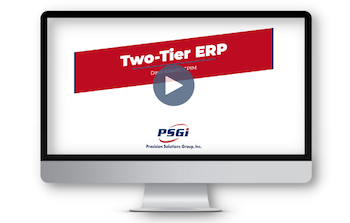 How can ERP software be aligned to business requirements that vary across different business units, subsidiaries, and geographies? In this blog, we explore how a “two-tier” ERP can provide an effective solution.
How can ERP software be aligned to business requirements that vary across different business units, subsidiaries, and geographies? In this blog, we explore how a “two-tier” ERP can provide an effective solution.
What are ERP tiers?
An ERP tier refers to a technology deployment strategy for different business units and/or geographic business locations. In short, a one-tier ERP system seeks to provide the same, unified ERP environment across the entire organization. By contrast, two-tier ERP systems tailor functionality to the needs and resources of specific business units, subsidiaries, and locations.
We take a look at both approaches, including their pros and cons, below. For a deeper dive into this topic, take a look at our recorded webinar here.
The Traditional Approach: One-Tier ERP
A one-tier ERP was the standard for every organization for decades. Not so long ago, a single ERP system across the entire enterprise was the only real option for most enterprises. And this model does offer proven benefits:
- Centralized IT management.
- All users across the organization use the same application and data, simplifying training and support.
- Technological simplicity reduces the number of skills, vendors, and integration tasks required.
The streamlined nature of a one-tier approach still has value today. In the past, a one-tier ERP approach was thought to be the pinnacle of efficiency as well. However, experience has shown that this monolithic approach to ERP systems does have its drawbacks.
A one-size-fits-all approach risks driving compromised functionality for some parts of the business while introducing unnecessarily expensive, overkill functionality for others (especially smaller regional offices or small acquired companies). An enterprise-wide ERP rollout is a major investment in time, money, and resources; consider the implementation costs, the license fees, and the maintenance support fees associated with large tier-one ERP software (many of which persist into perpetuity).
These systems can also be highly complex to configure, particularly when different business units do not have consistent business environments. For some business units, a generalized ERP software may lack the flexibility to fit all business requirements, forcing industry-standard approaches that do not necessarily reflect unique business practices. At worst, this lack of flexibility can even harm competitiveness by ignoring unique business processes. But customizing this software for each business unit negates the very simplicity this approach was supposed to provide in the first place!
Benefits of a Two-Tier ERP Approach
In a two-tier ERP model, the first tier is a “corporate” or “central” ERP. This foundational tier is typically employed for global finance functions, corporate-level sales, and any other functions which may be unified across all business units.
The second tier refers to the ERP(s) used only by certain divisions, subsidiaries, and/or regional locations. These second-tier systems can be more readily customized to address specific needs, without increasing the complexity of the common core ERP software. A two-tier ERP can also be an ideal solution for newly acquired businesses that have their own technology environments and business processes. Another prototypical rationale is the ability to roll out modern software for corporate operations while retaining highly-customized legacy software for back-end operations.
While employing different ERP systems may appear more complex, this approach offers valuable distinct strategic advantages:
- The front-end, tier-two systems can be lightweight, user-friendly, and tuned to allow for streamlined use by employees in their day-to-day tasks.
- The back-end, tier-one system can leverage the process data generated by the front-end systems for more complex, specialized workflows. Common examples include consolidating finances, invoicing sales orders, business reporting, and performing executive-level functions.
- The ability to modify back-end systems without customizing a monolithic ERP architecture provides added flexibility, agility, and adaptability while enabling geographic autonomy (crucial for meeting local needs like currency, language, taxation, etc.).
- ERP software aligned to specific business unit needs can help improve efficiency, while a modern UI helps improve productivity at the regional level.
- Separate back-end solutions make it easier to store and process sensitive data in a secure environment.
Some companies may see a two-tier ERP approach as an expensive option that is only economical for large multinational enterprises with sprawling divisions and diverse functional requirements. But costs are coming down for virtually all of the critical ingredients of a two-tier ERP approach, including license fees and integration costs. In this context, this strategy is a cost-effective option for many more companies than in the past, including many medium-sized companies. In fact, it can even be the most cost-effective solution for many businesses today, as it avoids spending on overkill functionality. While a two-tier ERP approach is more accessible than ever, it does have its downsides.
Cons of a Two-Tier ERP Approach
- Some IT organizations demand unified control at the corporate level. If this is the case, a two-tier ERP is not viable.
- A two-tier approach introduces new integration requirements, which can be technologically challenging. However, the tools available today make this work dramatically easier and less expensive.
- Master data management practices are required to eliminate data inconsistencies and redundancies.
- The central IT department may no longer oversee training for each tier-two ERP, which may add to organizational complexity.
- The need to manage relationships with multiple software vendors.
Which ERP Deployment Strategy is Right for your organization?
Both of these approaches can be viable, and the right solution will depend on your organizational needs. A tier-one approach has been proven for decades, while PSGi’s own experience confirms how valuable a tier-two strategy can be in some representative business situations.
One client, a multinational dairy producer, uses SAP for all of their European offices (including core corporate functions), while their American offices use PRISM. PRISM may be localized for US-specific business needs but is fully integrated with data in the SAP system in Europe. Another client, a large adhesives manufacturer, uses double-byte SAP ERP to address their Japanese subsidiary’s language requirement while using a single-byte solution for the rest of their global organization.
For a deeper discussion of this topic, including key questions to ask when evaluating the right path for your business issues discussed above, watch our webinar here.
Or, if you need help deciding which ERP deployment strategy is right for your organization, we encourage you to reach out to our team.



